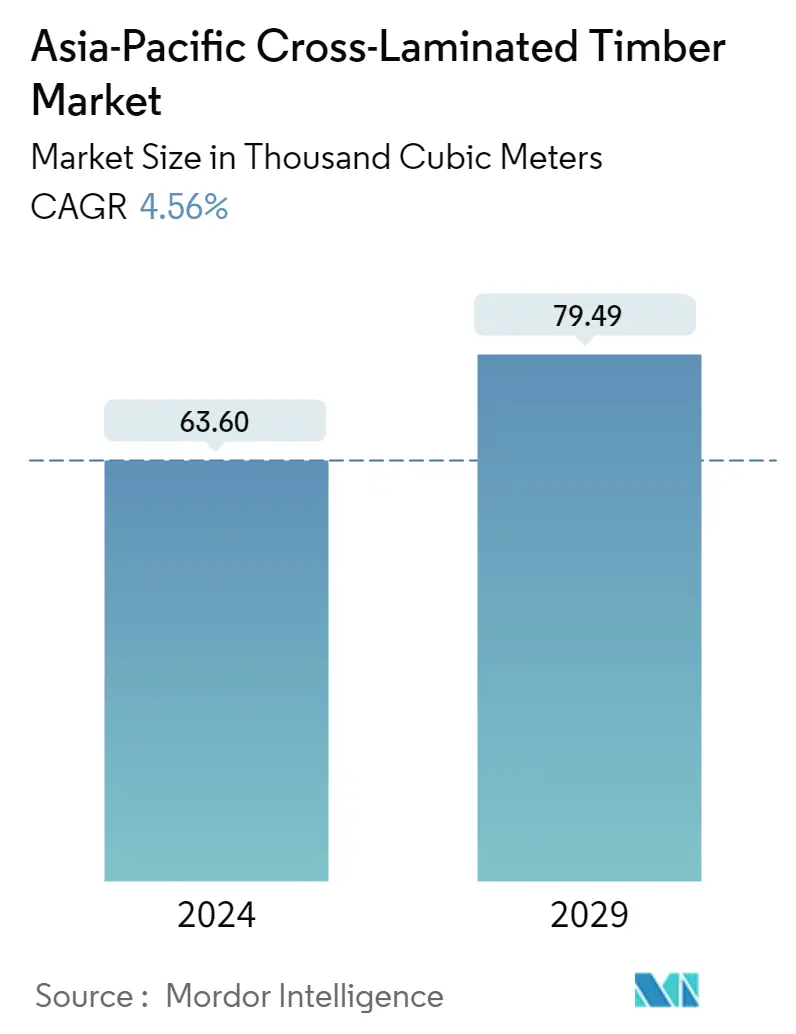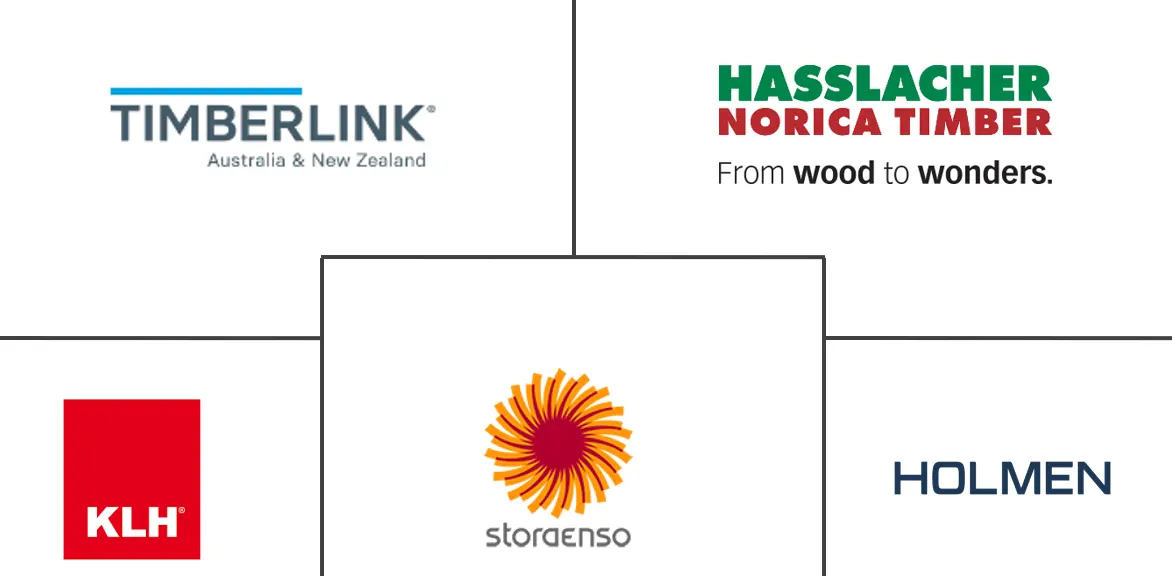Market Size of Asia-Pacific Cross-Laminated Timber Industry

| Study Period | 2019 - 2029 |
| Base Year For Estimation | 2023 |
| Market Volume (2024) | 63.60 Thousand cubic meters |
| Market Volume (2029) | 79.49 Thousand cubic meters |
| CAGR (2024 - 2029) | 4.56 % |
| Market Concentration | High |
Major Players
*Disclaimer: Major Players sorted in no particular order |
Asia-Pacific Cross-Laminated Timber Market Analysis
The Asia-Pacific Cross-Laminated Timber Market size is estimated at 63.60 Thousand cubic meters in 2024, and is expected to reach 79.49 Thousand cubic meters by 2029, growing at a CAGR of 4.56% during the forecast period (2024-2029).
The Asia-Pacific cross-laminated timber market was negatively impacted by COVID-19. The implementation of stringent lockdown measures led to a halt of industrial operations. However, the sector has been recovering well since restrictions were lifted. The growth in industrial activities registered a positive trend for the cross-laminated timber market in the Asia-Pacific region.
- Over the short term, growing commercial sectors in the region are the major factor driving the growth of the market studied.
- However, moisture absorption-related risks of the material are the key factors anticipated to restrain the growth of the target industry over the forecast period.
- Nevertheless, the carbon-negative future based on cross-laminated timber is likely to create lucrative growth opportunities for the global market soon.
- China emerged as the largest growing market for cross-laminated timber in the region owing to considerable consumption of the material across the country for various applications.
Asia-Pacific Cross-Laminated Timber Industry Segmentation
Cross Laminated Timber (CLT) is an engineered wood product, consisting of planks of sawn, glued, and layered wood, where each layer is oriented at right angles to one another and then glued to form structural panels. By joining layers of wood at perpendicular angles, structural rigidity for the panel is obtained in both directions, similar to plywood but with thicker components.
The Asia-Pacific cross-laminated timber market is segmented by type, application, and geography. By type, the market is segmented into adhesive bonded and mechanically fastened. By application, the market is segmented into residential and non-residential (commercial, industrial/institutional, and other applications). The report also covers the size and forecasts for the cross-laminated market in four countries across the Asia-Pacific. For each segment, the market sizing and forecasts have been done based on volume (thousand cubic meters).
| Type | |
| Adhesive Bonded | |
| Mechanically Fastened |
| Application | |||||
| Residential | |||||
|
| Geography | |
| China | |
| India | |
| Japan | |
| South Korea | |
| Rest of Asia-Pacific |
Asia-Pacific Cross-Laminated Timber Market Size Summary
The Asia-Pacific cross-laminated timber market is poised for growth, driven by the increasing demand in the commercial construction sector. This market, which experienced setbacks due to the COVID-19 pandemic, is on a recovery trajectory as industrial activities resume. Cross-laminated timber (CLT) is gaining traction as a sustainable alternative to traditional building materials like steel and concrete, thanks to its low carbon footprint and aesthetic appeal. The material is being increasingly used in various commercial buildings across the region, including significant projects in Australia and Singapore. China's robust consumption of timber and its ongoing infrastructure investments further bolster the market's expansion, despite challenges such as moisture absorption risks.
The market landscape in the Asia-Pacific region is characterized by a few key players, including Stora Enso, Timberlink Australia & New Zealand, KLH Massivholz GmbH, HASSLACHER Holding GmbH, and Holmen. These companies are actively expanding their operations and product offerings to meet the growing demand for sustainable construction solutions. For instance, Stora Enso's introduction of the Sylva product line underscores the industry's shift towards innovative and eco-friendly building materials. The market's growth is also supported by government initiatives in China aimed at revitalizing the construction sector, which is expected to drive further demand for cross-laminated timber in the coming years.
Asia-Pacific Cross-Laminated Timber Market Size - Table of Contents
-
1. MARKET DYNAMICS
-
1.1 Drivers
-
1.1.1 Growing Commercial Sector in the Region
-
1.1.2 Increasing Popularity of Cross-Laminated Timber Over other Traditional Wood Materials
-
-
1.2 Restraints
-
1.2.1 Moisture Absorption Related Risks of the Material
-
1.2.2 Other Restraints
-
-
1.3 Industry Value Chain Analysis
-
1.4 Porter's Five Forces Analysis
-
1.4.1 Bargaining Power of Suppliers
-
1.4.2 Bargaining Power of Consumers
-
1.4.3 Threat of New Entrants
-
1.4.4 Threat of Substitute Products and Services
-
1.4.5 Intensity of Competitive Rivalry
-
-
-
2. MARKET SEGMENTATION (Market Size in Volume)
-
2.1 Type
-
2.1.1 Adhesive Bonded
-
2.1.2 Mechanically Fastened
-
-
2.2 Application
-
2.2.1 Residential
-
2.2.2 Non-Residential
-
2.2.2.1 Commercial
-
2.2.2.2 Industrial/Institutional
-
2.2.2.3 Other Applications
-
-
-
2.3 Geography
-
2.3.1 China
-
2.3.2 India
-
2.3.3 Japan
-
2.3.4 South Korea
-
2.3.5 Rest of Asia-Pacific
-
-
Asia-Pacific Cross-Laminated Timber Market Size FAQs
How big is the Asia-Pacific Cross-Laminated Timber Market?
The Asia-Pacific Cross-Laminated Timber Market size is expected to reach 63.60 thousand cubic meters in 2024 and grow at a CAGR of 4.56% to reach 79.49 thousand cubic meters by 2029.
What is the current Asia-Pacific Cross-Laminated Timber Market size?
In 2024, the Asia-Pacific Cross-Laminated Timber Market size is expected to reach 63.60 thousand cubic meters.

